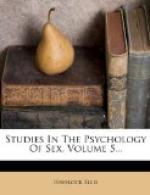The case of a schoolmistress recorded by Penta instructively shows how an erotic symbolism of this last kind may develop by no means as a refinement of vice, but as the one form in which sexual gratification becomes possible when normal gratification has been pathologically inhibited. F.R., aged 48, schoolmistress; she was some years ago in an asylum with religious mania, but came out well in a few months. At the age of 12 she had first experienced sexual excitement in a railway train from the jolting of the carriage. Soon after she fell in love with a youth who represented her ideal and who returned her affection. When, however, she gave herself to him, great was her disillusion and surprise to find that the sexual act which she had looked forward to could not be accomplished, for at the first contact there was great pain and spasmodic resistance of the vagina. There was a condition of vaginismus. After repeated attempts on subsequent occasions her lover desisted. Her desire for intercourse increased, however, rather than diminished, and at last she was able to tolerate coitus, but the pain was so great that she acquired a horror of the sexual embrace and no longer sought it. Having much will power, she restrained all erotic impulses during many years. It was not until the period of the menopause that the long repressed desires broke out, and at last found a symbolical outlet that was no longer normal, but was felt to supply a complete gratification. She sought the close physical contact of the young children in her care. She would lie on her bed naked, with two or three naked children, make them suck her breasts and press them to every part of her body. Her conduct was discovered by means of other children who peeped through the keyhole, and she was placed under Penta for treatment. In this case the loss of moral and mental inhibition, due probably to troubles of the climacteric, led to indulgence, under abnormal conditions, in those primitive contacts which are normally the beginning of love, and these, supported by the ideal image of the early lover, constituted a complete and adequate symbol of natural love in a morbidly perverted individual. (P. Penta, Archivio delle Psicopatie Sessuali, January, 1896.)
FOOTNOTES:
[1] The term “erotic symbolism” has already been employed by Eulenburg (Sexuale Neuropathie, 1895, p. 101). It must be borne in mind that this term, implying the specific emotion, is much narrower than the term “sexual symbolism,” which may be used to designate a great variety of ritual and social practices which have played a part in the evolution of civilization.
[2] Sexual Selection in Man, iv, “Vision.”
[3] K. Groos, Der AEsthetische Genuss, p. 122. The psychology of the associations of contiguity and resemblance through which erotic symbolism operates its transference is briefly discussed by Ribot in the Psychology of the Emotions, Part 1, Chapter XII; the early chapters of the same author’s Logique des Sentiments may also be said to deal with the emotional basis on which erotic symbolism arises.




